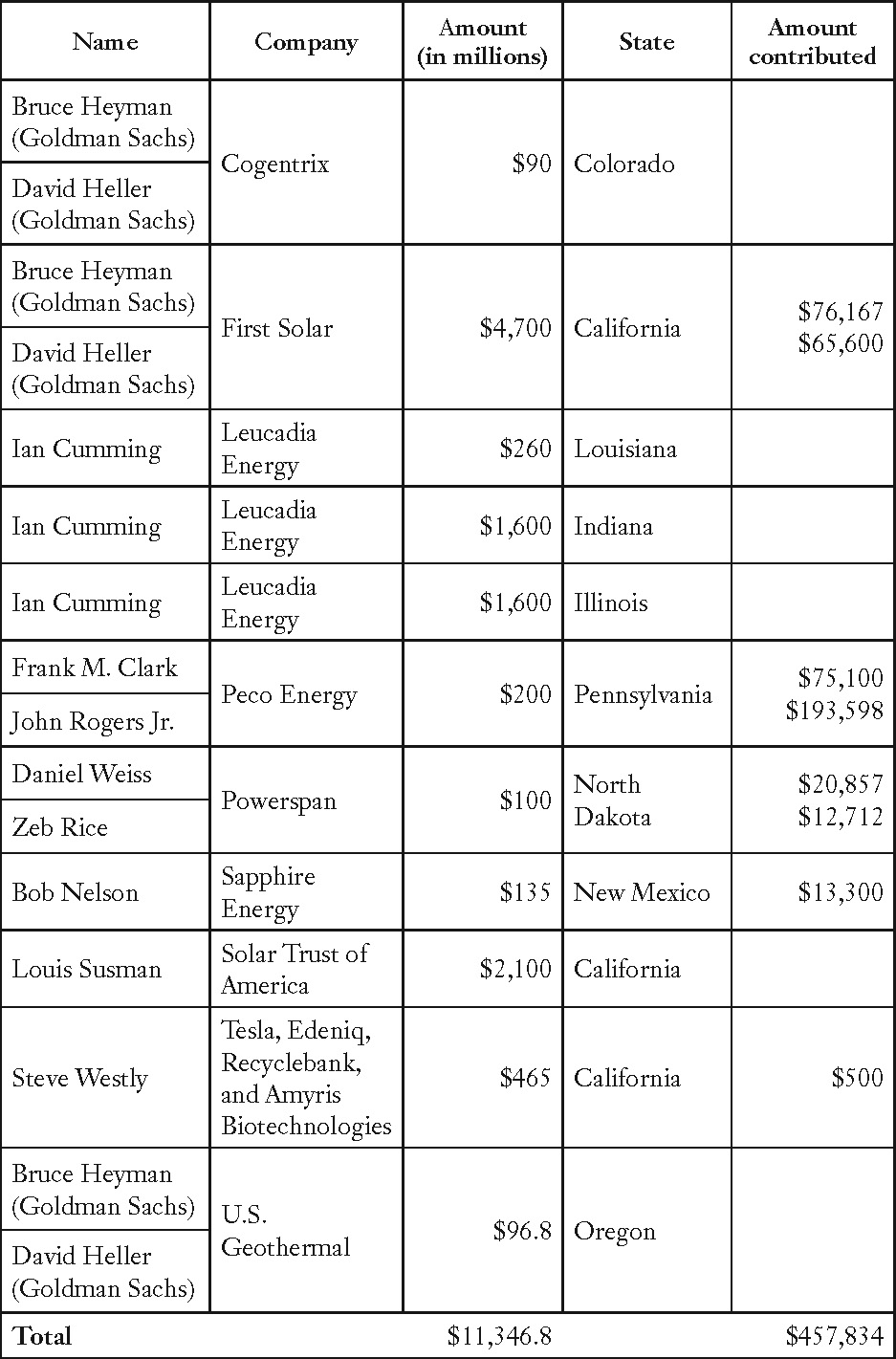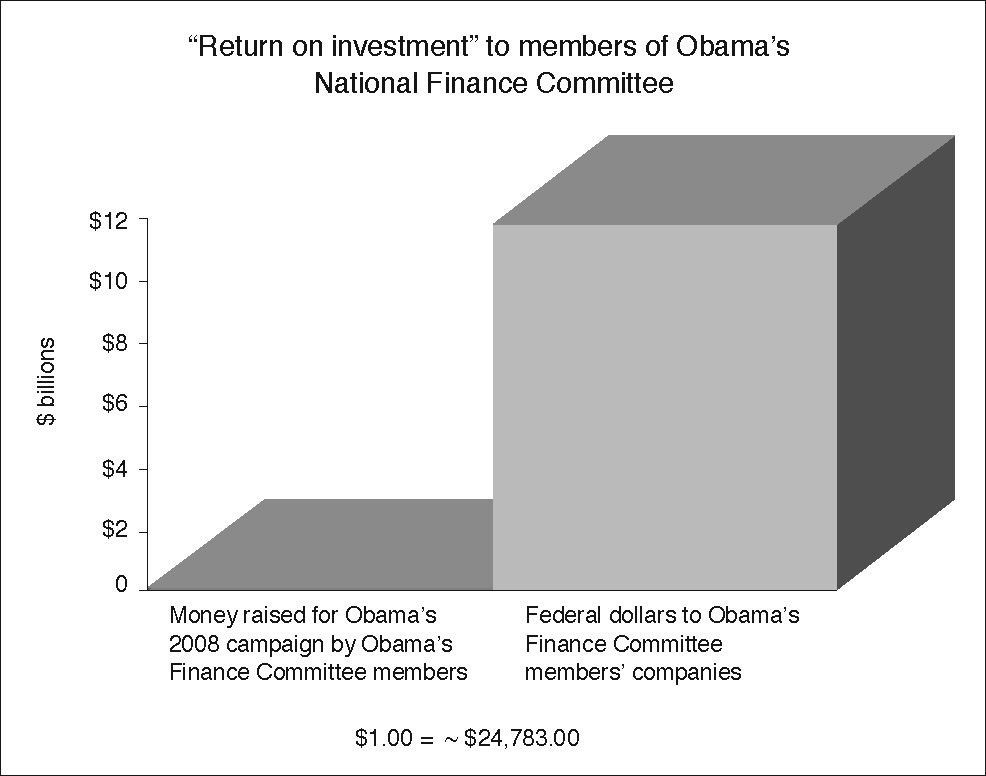Throw Them All Out (12 page)
Read Throw Them All Out Online
Authors: Peter Schweizer

White House involvement is particularly interesting because several loans appear to have gone to companies with direct connections to senior White House staff. Granite Reliable Wind, for example, was offered $135 million in loan guarantees. Why is that significant? Because it is largely owned and managed by CCMP Capital, which is where the White House Deputy Chief of Staff Nancy-Ann DeParle had been managing director before joining the Obama administration.
The alternative energy loan and grant programs were originally created in 2005, but they were not very active. Indeed, hardly any loans and grants were offered during the Bush years. The reason? The 2005 law required that the companies receiving loans or grants have a sizable amount of their own money in the game, a "down payment" on projects. But the 2009 stimulus bill removed that provision. Wealthy investors in green-tech companies could now get large government "investments" with very little of their own money at risk.
These government grants and loan guarantees are important not only because they provide access to taxpayer (or taxpayer-guaranteed) capital. Such support also serves as a "seal of approval" from the federal government, opening up access to other private capital. The stock prices of firms rise and fall simply on the news that their applications are under consideration. In May 2011, for example, when it was revealed that First Solar, a sustainable-energy company, was merely "in the running" for government loans and grants, the company's stock rose 5% on the news.
Forbes
even speculated that thanks to the government loans and grants, Americans might well "mint several 10-figure fortunes."
7
As Faysal Sohail, the managing director of the venture firm CMEA Capital, told the
San Francisco Business Journal,
"Getting $25 million from the government does make a difference to investors."
8
The crony-capitalist road to riches was simple: invest in a green-tech company, secure a much larger investment from the federal government, take your company public, and make lots of money. Indeed, as President Obama's Council of Economic Advisers estimated, by July 2010 the government grants and guaranteed loans had stimulated an additional $134 billion of private investment in green- energy firms.
9
Â
The attorney and lobbyist Steve Farber, a major donor to the Democratic National Committee and cochair of the host committee for the 2008 convention in Denver, which nominated Obama for President, understood exactly how the system worked. He had raised $40 million for the inauguration, and now he could raise some cash for himself.
10
Shortly after the federal government started writing Recovery Act grant checks, Farber boldly placed an ad in the
Wall Street Journal
touting the services and connections of his firm, Brownstein Hyatt Farber Schreck. "Expertise in sustainable energy law is worth nothing without connections," it read. "Learn how we've helped clients obtain funding from the Department of Energy through the American Recovery and Reinvestment Act."
Farber was blunt, but he spoke the truth in a way that only a lobbyist will sometimes do. He was right: when it came to getting access to tens of billions of dollars in taxpayer money, passed around as a stimulus for the economy, connections were the key.
Another Obama fundraiser, Steve Westly, echoed that sentiment. In addition to amassing more than $500,000 for Obama's election in 2008, Westly cochaired California's Obama for President campaign. Westly is a Silicon Valley venture capitalist who also advises high-tech start-ups on financial matters. And like Farber, he has not been subtle about advertising the Obama connection.
"We believe that with the Obama Administration, and other governments ... committing hundreds of billions of dollars to clean tech, there has never been a better time to launch clean tech companies," reads his company's website. "The Westly Group is
uniquely positioned
to take advantage of this surge of interest and growth."
In addition to regularly attending White House events and state dinners (he was on hand to greet the Chinese premier), Westly also serves on the advisory board of the Department of Energy. Four companies in which Westly had a major financial stake just happened to receive loans, grants, or stimulus money from the Obama Energy Department: Tesla, Recyclebank, Edeniq, and Amirys Biotechnologies. And at least two other companies that later joined his portfolio, Amonix and CalStar Products, received Department of Energy funding.
As a joint investigation of Westly by ABC News and the Center for Public Integrity makes clear, he confidently traded on his connection to Obama, mentioning it in e-mails to Department of Energy officials with whom he was discussing business.
11
But Westly was only one player in a very large drama.
The first guaranteed loan provided by the Obama administration for alternative energy was massive: $573 million for a solar energy company called Solyndra. The company got a low interest rate and the knowledge that if it could not repay what it owed, the government would pick up the tab. In short, a very nice deal. President Obama paid two visits to Solyndra's California factory to tout the grant. As it turned out, 35% of the company was owned by an Oklahoma billionaire named George Kaiser, who was a bundler for the 2008 Obama presidential campaign. (Each Obama bundler raised a minimum of $100,000 for the election.)
12
Nonetheless, since receiving the loan Solyndra has declared bankruptcy, laid off workers, and closed down its first factory.
13
The economic reality is that Solyndra loses money on every solar panel it sells. The company has never been profitable. The plan was simple, and would become a pattern with other companies: secure government money, go public, and get out. As one investor in Solyndra told the
Wall Street Journal:
"There was a perceived halo around the loan. If we get the loan, then we can definitely go public and cash out."
14
Based on the terms of the taxpayer-backed loan, Kaiser and other investors will be paid
before
the government.
That loan set the tone for a whole series of others, as well as for outright grants offered to a large collection of Obama financiers. One of the biggest apparent winners in the sweepstakes for taxpayer dollars was a company called Leucadia Energy. The company gained approval for a number of projects running into the billions of dollars. It received $260 million for an industrial carbon capture project in Lake Charles, Louisiana; approval for $1.6 billion in loan guarantees for a coal gasification project in Indiana; and another $1.6 billion for a synthetic gas project to be based in Chicago. (Some of these projects have faced local opposition because of concerns about pollution, and have not been completed.)
15
So how on earth did Leucadia Energy manage to attract so much federal money? According to
Manta.com
, an aggregator of public information about small businesses, Leucadia at the time of the government's decision had one employee and $120,000 in annual revenue. The company is a subsidiary of Leucadia National, whose chairman and CEO is Ian Cumming. Cumming served as a member of President Obama's 2008 National Finance Committee and was on the 2008 Democratic National Convention Committee. Curiously, Ian Cumming wrote three rather large checks to Democratic Party committees just weeks before his funds were approved. He wrote a total of $69,900 in checks in April 2009.
The ostensible purpose of these massive stimulus loans to Leucadia was to create jobs. But according to a government audit, as of December 2010, eighteen months after the loans were made, the Leucadia projects had resulted in a grand total of three jobs.
16
Â
A total of $2.1 billion was offered to Solar Trust of America to build a solar facility. Both Citigroup Global Partners and Deutsche Bank have a lot of money at stake, $6 billion. The vice chairman of Citigroup Global Partners was, until recently, Louis Susman. And who is Susman? He sat on Obama's National Finance Committee and raised so much for the Obama campaign that he got the nickname "the Vacuum Cleaner." In appreciation, Obama made him ambassador to Great Britain. Deutsche Bank North America's CEO, Seth Waugh, was an Obama campain bundler. The project's partner is Chevron, which heavily favored Obama over McCain in 2008 campain contributions.
17
A company called Solar Reserve received $737 million in loan guarantees. One of the largest investors in Solar Reserve is CitiAlternatives. The head of CitiAlternatives, before he joined the Obama administration, was Michael Froman. Obama and Froman first met at Harvard Law School, where they served on the
Law Review
together. When Obama ran for the U.S. Senate in 2004, Froman introduced him to major Democratic Party players like Robert Rubin, raised money for the campaign, and advised Obama on policy. When Obama ran for President, Froman helped raise large sums of money on Wall Street. After he secured election, Obama asked Froman to join him in the White House as deputy assistant to the President and deputy national security adviser.
DEPARTMENT OF ENERGY GRANT AND LOAN RECIPIENTS FROM THE OBAMA CAMPAIGN'S NATIONAL FINANCE COMMITTEE
 Â
Â
INVESTING IN POLITICIANS CAN BE HIGHLY PROFITABLE
 Â
Â
A company called Brightsource received $1.4 billion in loan guarantees to build the Ivanpah Solar Electrical System on federal land in California. Who owns Brightsource? By far the single largest shareholder (25%) is Mr. Wagle's VantagePoint Partners. One of only four partners at the firm is Robert Kennedy Jr., from that famous political family. Although he initially supported Hillary Clinton, Kennedy came around to supporting Obama, comparing him to his father and his uncle. He declared during the election that Obama was a "transformational figure in American history who's been able to excite the same intensity and feeling amoung Americans as I saw during my father's 1968 campaign and my uncle John F. Kennedy's 1960 campaign." Now an environmentalist and an investor in green technologies, Kennedy wrote an article for
CNN.com
in the summer of 2008 with the apt title "Obama's Energy Plan Would Create a Green Gold Rush." And now Kennedy was in a good position to cash in.
Brightsource badly needed this infusion of taxpayer cash. It had been losing lots of money. It had debt obligations of $1.8 billion and in 2010 lost $71.6 million on revenue of just $13.5 million. The company was blunt in its filings with the Securities and Exchange Commission: "Our future success depends on our ability to construct Ivanpah, our first utility-scale solar thermal power project, in a cost-effective and timely manner." And there were no guarantees: "Our ability to complete Ivanpah and the planning, development and construction of all three phases are subject to significant risk and uncertainty."
18
A billion dollars in taxpayer money being sent to wealthy investors to bail them out of risky investmentsâdoes this sound familiar to anyone?
Â
Another alternative energy company, Abound Solar, cashed in $400 million in grants to increase its production of solar panels. One of the first and largest investors in Abound was billionaire heiress Pat Stryker, who invested through her company, Bohemian. An early financial supporter of the Obama campaign, Stryker has given hundreds of thousands of dollars to Democrats, $87,000 to Obama's Inauguration Committee, and $500,000 to the Coalition for Progress.
19
A company mentioned earlier, First Solar, received a whopping $4.7 billion in loan guarantees for three solar projects. And who is behind First Solar? The biggest investors include billionaire Ted Turner, a big financial backer of Obama's in 2008, and Goldman Sachs. The financial giant's employees gave Obama more than $1 million in campaign contributions in 2008, making it one of his largest contributors.
20
And two Goldman executives sat on Obama's 2008 National Finance Committee. As a bonus, perhaps, billionaire investor Paul Tudor Jones, another Obama bundler, also owns a stake in First Solar, whose CEO, Michael Ahearn, gives generously (and exclusively) to Democrats.